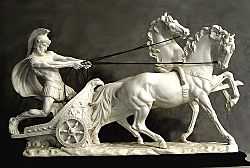Gaius Appuleius Diocles facts for kids
Quick facts for kids Gaius Appuleius Diocles |
|
|---|---|
 |
|
| Nickname | The Lamecus |
| Born | 104 AD Lamecum, Roman Empire (now Lamego, Portugal) |
| Died | after 146 AD Praeneste, Roman Empire (now Palestrina, Italy) |
| Nationality | Roman |
| Career wins | 1,462 |
Gaius Appuleius Diocles (born in 104 AD and died after 146 AD) was a famous Roman charioteer. He became one of the most celebrated athletes in ancient history. Many people say he was the highest-paid athlete of all time.
Contents
Who Was Gaius Appuleius Diocles?
Early Life and Start in Racing
Gaius Appuleius Diocles was born around 104 AD. His hometown was Lamecum, which is now Lamego, Portugal. His family was quite well-off because his father owned a small transport business.
Diocles started racing chariots when he was about 18 years old. His first big win outside his home area was in Ilerda, which is now Lleida, Spain. This victory made him famous internationally. It also encouraged him to move to Rome, the center of the Roman Empire.
Racing Career in Rome
Diocles began his racing career in Rome in 122 AD. He first joined a racing team known as the Whites. He didn't win a race for two years after joining them. People started calling him "the Lamecus," which brought fame to his hometown. A statue was even built for him in Lamecum.
He usually raced quadrigae, which are chariots pulled by four horses. Diocles was also special because he owned a very rare horse called a ducenarius. This was a horse that had won at least 200 races!
An Amazing Charioteer
Records show that Diocles won 1,462 out of the 4,257 four-horse races he entered. He also finished in second place in another 1,438 races. He was known as the "Champion of Charioteers." His popularity and success at the Circus Maximus made him one of the best-known ancient athletes. The Circus Maximus was a huge stadium in Rome where chariot races took place.
Diocles was also a great showman. He often won races by coming from behind. He would cross the finish line at the very last moment. This made his races very exciting for the fans. Any race with Diocles quickly became the most important event of the day. This helped him earn even more money.
He had a very long career for a charioteer, racing for 24 years. He raced for three of the four most famous chariot racing teams in Rome. These teams were known by their colors: Reds, Whites, Blues, and Greens. He started with the Whites at age 18. After six years, he switched to the Greens for three years. Then, he raced for the Reds for 15 years. He retired at the age of 42. After he retired, he eventually died in a small town called Praeneste.
His Incredible Winnings
Diocles' total winnings were an amazing 35,863,120 sesterces. Sesterces were a type of Roman money. This amount was equal to about 2,600 kilograms of gold!
To give you an idea of how much that was:
- His earnings could buy enough grain to feed the entire city of Rome for a whole year.
- It could also pay the Roman army for about a fifth of a year.
- Experts say his wealth was like having between $60 million and $160 million in today's money.
- In just one day, he earned more than a Roman official called a procurator made in a whole year.
- His wealth was greater than almost all the richest Roman senators.
See Also
 In Spanish: Cayo Apuleyo Diocles para niños
In Spanish: Cayo Apuleyo Diocles para niños

